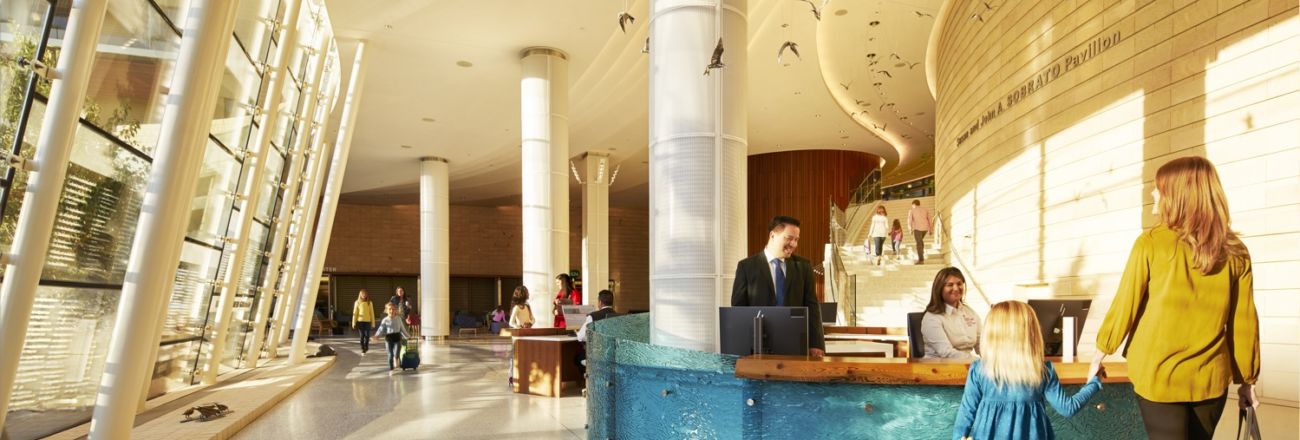Achieving integrated design usually means operating under a strong relationship. Working on the expansion of the new Lucile Packard Children’s Hospital Stanford, I formed an especially strong bond over the project’s evolution with my buddy Breeze Glazer. Breeze is the Sustainable Healthcare Leader for Perkins+Will, and I’m heavily immersed in “all things energy” for Mazzetti.
Over the many (many) years that it took to build this hospital, we were struck time and again at just how reliant our work was on the twin ideas of trust and relationship-building. We were also drawing on another relationship, that of Perkins+Will’s Healthcare Principal and Project Director for the hospital expansion, Robin Guenther, FAIA, and Walt Vernon, the CEO of Mazzetti. Robin and Walt have formed a connection (over time) where advancing sustainability is a driving force.
When you walk into Packard Children’s, you know you’ve entered a special place. The building, which opened its doors to patients this past December, was, from the start, intended to be the most sustainable hospital in the world. The entire design and construction team—Perkins+Will, Mazzetti, HGA, and DPR Construction—was instrumental in finding ways to back up that claim.
As Robin and Walt will tell you, Packard Children’s was designed specifically to have a positive impact on health—a striking percentage of buildings, even hospitals, aren’t actually designed to improve health. Some even do the opposite. To that end, the hospital’s windows, daylighting, mechanical systems and ventilation, access to nature—everything was selected after asking, “How does this improve the delivery of care?” This building is a home away from home for children with life threatening or chronic illnesses and their families. So, our highest priority was to create a healing environment.
In the design world, a healthy building is a high-performing building. We noticed very early in the design process, given our massive emphasis on performance, that this project was going to require a new level of integration. And truly integrated design yields a building that is unique to its collaboration.
This building is a home away from home for children with life threatening or chronic illnesses, and their families. So, our highest priority was to create a healing environment.
A few of our decisions were instrumental in shaping the hospital’s precedent-setting sustainability profile. We hope they might prompt ideas for any HVAC-minded readers—healthcare facility directors and beyond—who have a chance to impact their own operations.
Critical Schematic Design Collaboration
Early in the Schematic Design phase, we evaluated a range of approaches to the HVAC system. Beyond energy savings, we considered several factors: architectural impact and cost, ease of operations, and impact on users and occupants. Mazzetti’s energy model analyzed the life-cycle cost benefits for each option. We also gave key stakeholders, including the facilities team, a chance to voice their comfort with operating the systems upon completion.
So, fully equipped—with energy modeling data, key stakeholder input, architectural impact, and cost estimates—we found the most suitable systems that could inform our architectural design. Collaborating so early in Schematic Design is one of the key reasons the building’s performance is so highly developed.
Displacement Ventilation Systems
Another critical factor was our use of displacement ventilation. In 2007, just prior to the starting work on Packard, Mazzetti formed a collaborative to evaluate alternative ventilation strategies for healthcare facilities. This research went through rigorous testing procedures utilizing Computational Fluid Dynamics modeling and physical lab testing. It was subsequently validated by the National Institute of Health, amended to ASHRAE’s Standard 170 and adopted into code. The benefits were clear: displacement ventilation greatly reduced energy consumption, improved the removal of airborne particulate matter, and increased the efficiency of ventilation overall. At Packard, patient comfort wouldn’t be too far behind.
Architecturally Integrated Building Systems
We integrated building systems into the architecture. Upon selecting the building systems, we identified architectural features that could, essentially, “hide” them. For instance, as you enter the hospital’s dramatic yet welcoming lobby, you’ll notice majestic white columns throughout the space. Less obvious is the ventilation infrastructure housed within these columns.
Typically, displacement ventilation (DV) is best used in an environment with high ceilings, in which only the lowest six feet needs conditioning. Here, however, the vastness of the lobby posed a challenge for thorough, uniform distribution. Using the height of the columns to mask and house the necessary DV duct work proved to be one of our most significant design integrations. We’re going to closely track the DV performance at Packard, which is one of the first inpatient US hospitals to utilize DV. (In fact, all of Packard’s systems will be monitored continuously to understand actual performance. “Future-proofing” our work creates intel for future opportunities.)
DV systems are further masked in the individual patient rooms. A DV system requires air introduction from the ground up. But concealing its duct work at ground level usually consumes valuable square footage. We discovered that the foot of the bed could be incorporated into the solution, integrating the casework around the DV diffuser. This yielded benefits for the patient and, in regard to energy savings, the building.
When you’re working in a healthcare environment, especially when you’re working on behalf of children, considering how the space can positively contribute to the healing process and to the patient experience is no longer optional. Our design considerations included the kids and their families, creating an experience beyond that of being in an “institution.” Similarly, we can no longer consider sustainability an option. A building must perform, and perform in a way that reflects our collective responsibility as environmental stewards.
In other words, designing a healing place now means understanding how a building affects its people and its environment. We and the entire Packard team are proud to have brought that understanding to life.
